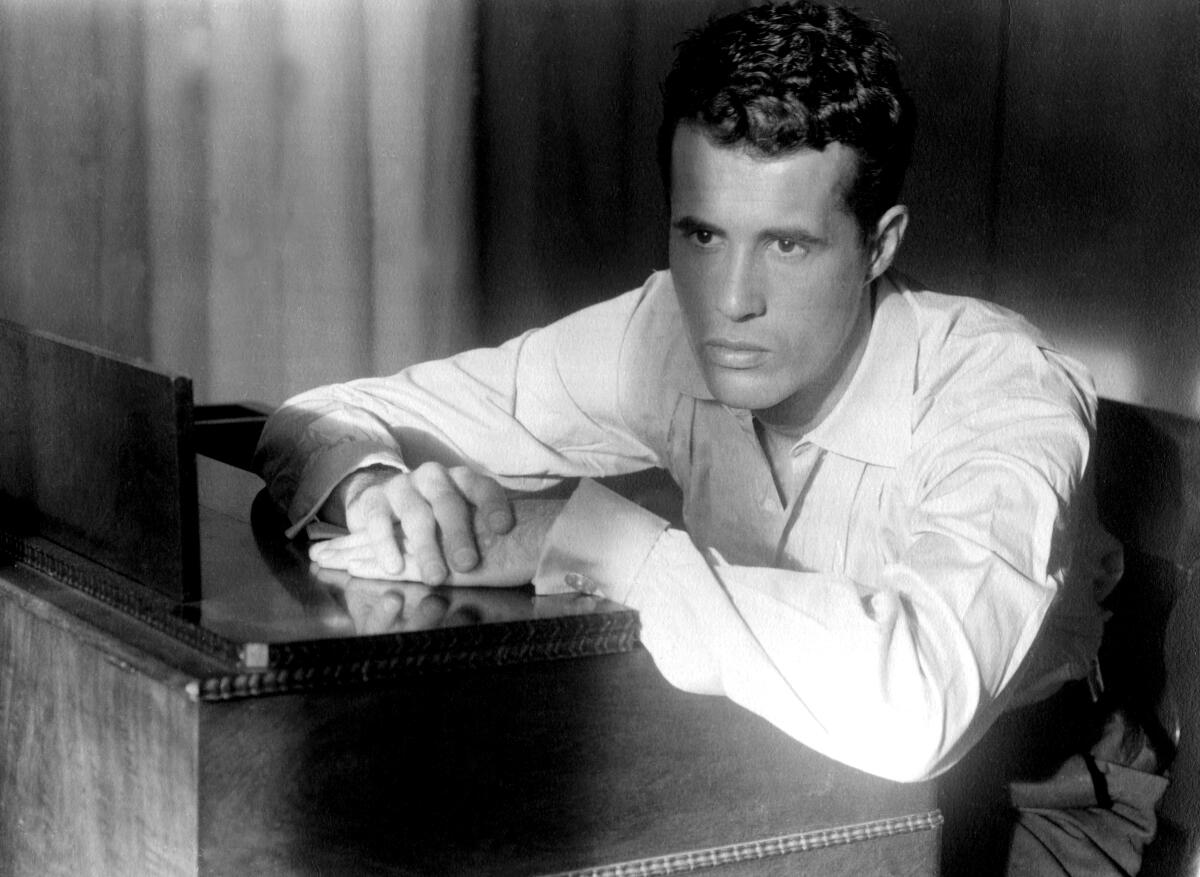Kenneth Anger, leading figure in L.A.’s underground film scene, dies

- Share via
Kenneth Anger, a leading figure in underground cinema who brought homoeroticism to the screen in the celebrated short films “Fireworks” and “Scorpio Rising” and whose techniques influenced filmmakers such as Martin Scorsese and David Lynch, has died. He was 96.
The filmmaker died of natural causes on May 11 in Yucca Valley, his artist liaison, Spencer Glesby, told the Associated Press on Wednesday.
Anger’s death was also announced Wednesday by Sprüeth Magers, the contemporary art gallery that presented exhibitions on his work.
A gay, self-described pagan with the name “Lucifer” tattooed on his chest, the Santa Monica-born Anger began his career in the 1940s. He remained a Hollywood outcast throughout his life, never directing a film for a major U.S. studio.
But he managed to collaborate with everyone from the sexologist Alfred Kinsey to rock star Mick Jagger. He made more than 20 short films and was recognized for giving a new visual lexicon to filmmakers from the New Hollywood movement that began in the mid-1960s, and to other directors who came later.
If President Bush is really serious about this business of fighting the Evil One and the Evil Axis, he might want to chat first with Kenneth Anger, who’s been on a first-name basis with the Prince of Darkness for decades.
Anger, whose filmmaking style included the use of jump cuts, glaring colors and demonic imagery, also claimed credit for inspiring the style of another visual artform that would arrive in the 1980s — the MTV music video.
“I wish they would hire me for something instead of just stealing my ideas. I mean, I could do with the work,” Anger told Observer Magazine in 2004.
Anger’s avant-garde style and his provocative depiction of gay sexuality began at age 20 with his 1947 surrealistic film “Fireworks,” in which he played a young man who is attacked by Navy sailors and doused in a milky substance.
A 1957 theatrical showing of “Fireworks” and a 1964 showing of “Scorpio Rising,” which had come out the year before, led prosecutors to file obscenity charges against two men who exhibited the films. In the two separate cases, a Los Angeles jury returned a guilty verdict against each man, but the convictions were overturned on appeal. Anger was not a defendant in the case.
Those cases came as the power of local authorities to censor films and performances was eroding across the nation.
In “Scorpio Rising,” Anger put a gay twist on the mystique and toughness of motorcycle riders, who had been a staple of Hollywood films for years. He shot bikers in leather gear and men dropping their pants at a party, then spliced the footage together with reverent depictions of Jesus Christ that Anger took from a Christian movie.
Aside from its shock value and brief nudity, the film stood out because Anger used a soundtrack of popular songs by the likes of Elvis Presley, Ray Charles and Ricky Nelson. He later said he paid to obtain rights to use the music in the film, even though it was customary at the time to hire an artist to compose an original score rather than wrestle with copyright issues.
Oscar-winning director Scorsese, in his book “Scorsese on Scorsese,” said that at New York University he was instructed to avoid using popular songs in his movies to avoid paying copyright fees, but that seeing “Scorpio Rising” changed all that.
“That gave me the idea to use whatever music I really needed,” Scorsese said.
Kenneth Anger, avant-garde film maker (“Lucifer Rising”) and chronicler of terrible Tinseltown in two “Hollywood Babylon” volumes, has returned from self-exile in Europe and NYC to film-adapt the outrageous books for producer Edward Pressman.
Scorsese’s breakthrough 1973 film “Mean Streets” would open with a montage of home movie-style footage of Italian Americans, set to the soundtrack of “Be My Baby” by the Ronettes. At the time, other films from the New Hollywood movement were also using popular songs for soundtracks, which eventually became standard in the movie industry.
Aside from Scorsese, other directors who acknowledged Anger’s early influence on their film careers included Gus Van Sant and John Waters, two filmmakers who, like Anger, have come out as gay.
In addition to challenging obscenity laws with his films, Anger gained notoriety by writing “Hollywood Babylon,” first published in France in 1959. The book became popular for its gossipy descriptions of the sex lives and gruesome deaths of celebrities — complete with photos of nude and mangled bodies. It was banned for years in the U.S. and was still considered adult fare when it was formally released in 1975. He had said he was working on a third book in recent years, with a chapter dedicated to Tom Cruise and Scientology, AP reported.
In the years leading up to his publication of a 1984 sequel, “Hollywood Babylon II,” Anger became as well known in some circles for his sharp-tongued tales of celebrities as for his films, according to “Anger,” a biography by the late writer Bill Landis.
Anger’s obsession with Hollywood and filmmaking began when he was a child.
His grandmother’s friend had worked in Hollywood, and Anger would later describe listening to her stories as his version of fairy tales.
Kenneth Anglemyer was born Feb. 3, 1927, in Santa Monica, the youngest child of a father who worked in Southern California’s airplane industry and a mother who had been left disabled after falling from a horse. He adopted the last name Anger when he made “Fireworks,” financing the film in part with money borrowed from his older brother that he never paid back, according to Landis’ biography.
Anger entered “Fireworks” in a European film festival run by the avant-garde French author and visual artist Jean Cocteau, who sent Anger a glowing letter. In response Anger moved to Europe, where he began work on a film project with Cocteau. It went nowhere and Anger moved on, striking up working relationships with other famous and infamous personalities.
He directed artist Marjorie Cameron and erotica author Anaïs Nin in his 1954 “Inauguration of the Pleasure Dome,” worked with Alfred Kinsey on a 1955 film about occultist Aleister Crowley — whose theology Anger had adopted as his own — and enlisted Jagger to create the score for his 1969 film “Invocation of my Demon Brother.”
For his long-gestating project “Lucifer Rising,” Anger initially sought out Led Zeppelin guitarist Jimmy Page to create the soundtrack. But the two had a falling out and Anger opted for music that Manson “family” member Bobby Beausoleil recorded in prison, releasing the film in 1980.
Some of his 21st century films included “Elliott’s Suicide,” about the late singer-songwriter Elliott Smith, and “Ich will” about the Hitler Youth in Nazi Germany.
He won awards for his body of work from the American Film Institute and the Los Angeles Film Critics Assn., and was featured in museum and gallery exhibitions around the world. He later joined the occult society Thelema and for a time lived in the house of Thelema founder Aleister Crowley, who was a friend and mentor.
But at times, he could barely make a living. When documentary filmmaker Kit Fitzgerald interviewed him for a 1981 television special, he had just sold his air conditioner because he was broke, according to the book “Anger.”
While he displayed venom for many Hollywood stars, he described his own work in poetic terms. Speaking to the Guardian in 2010, he said of his films, “They are close to being dreams — and in dreams, you don’t have to analyze what everything means.”
Dobuzinskis is a special Times correspondent.
More to Read
Only good movies
Get the Indie Focus newsletter, Mark Olsen's weekly guide to the world of cinema.
You may occasionally receive promotional content from the Los Angeles Times.










